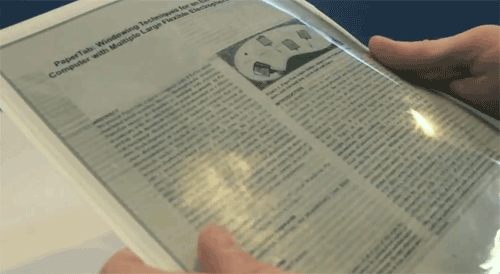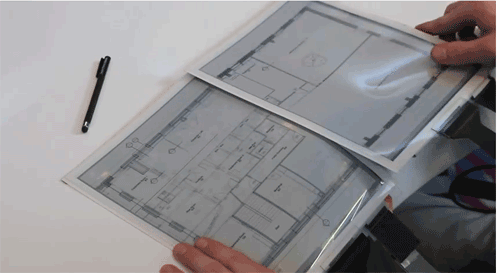Flexible paper computer looking to change the way people use tablets and computers
New mobile device introduced at CES 2013
A collaborative project among Queen’s University, Plastic Logic, and Intel Labs has yielded one of the more exciting unveilings at the start of CES 2013: a flexible paper computer.

The PaperTab tablet was created by a group made up of individuals from Queen’s University, Plastic Logic, and Intel Labs.
Dubbed the “PaperTab” tablet, the device looks and feels like a normal piece of paper, however, it’s fully interactive with a flexible, high-resolution 10.7-in. touchscreen plastic display powered by a second-generation Intel Core i5 Processor.

The PaperTab features a super-thin flexible display.
What makes the PaperTab particularly easy to use is that several apps or windows do not show up on a single display; rather, multiple interactive displays work together. This unique design choice allows a user the ability to thumb through different pages and use one app at a time.
“Using several PaperTabs makes it much easier to work with multiple documents,” says Roel Vertegaal, Director of Queen’s University’s Human Media Lab. “Within five to ten years, most computers, from ultra-notebooks to tablets, will look and feel just like these sheets of printed color paper.”
How it’s used
Let’s say a user wants to send a friend or family member a photo. They would simply tap one Paper Tab showing a draft e-mail against another PaperTab showing the photo. Doing this sends a wireless message that attaches the image to the draft e-mail. The e-mail can then be sent by placing the “e-mail” PaperTab in an out tray, or by bending the top corner of the display.

The PaperTab incorporates touch sensors so that the different “pages” can interact with one another.
Somewhat along the same lines, the PaperTab can also be used as a large drawing display. This is achieved when two or more PaperTabs are placed next to one another, emulating the natural handling of multiple sheets of paper by combining the device’s thin-film display, thin-film input and computing technologies together through intuitive interaction design.

PaperTab tablets can be combined to allow for larger-scale drawing capabilities.
Along with e-mails and large-scale drawing capabilities, PaperTab allows users to file and display thousands upon thousands of paper documents. What’s more, unlike tablets, PaperTabs keep track of each file’s location relative to one another and the user, to provide a seamless experience across all apps just like they were actual, physical computer windows.
What does that even mean? Well, here’s another example provided by the group: When a PaperTab is placed outside of reaching distance, it reverts the document to a thumbnail view of the file, just like icons on a desktop. When it gets picked up or touched, the device instantly switches back to a full-screen page view, as though the user opened the window on a computer.
Physically speaking
The PaperTab tablet is a thin, lightweight device. They can be tossed / dropped onto a desk, giving it a true magazine / newspaper-like reading experience. When the user bends one side of the display, they can navigate through pages just like a magazine, without needing to press a button.
“Plastic Logic’s flexible plastic displays are completely transformational in terms of product interaction. They allow a natural human interaction with electronic paper, being lighter, thinner and more robust compared with today’s standard glass-based displays. This is just one example of the innovative revolutionary design approaches enabled by flexible displays.” explains Indro Mukerjee, CEO of Plastic Logic.
Video
The following’s a short clip the team put together of the PaperTab tablet in action:
Story via: YouTube.com ■
Advertisement
Learn more about Electronic Products Magazine






